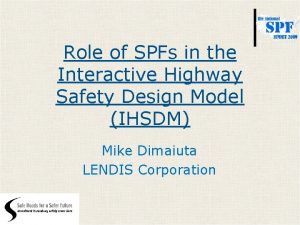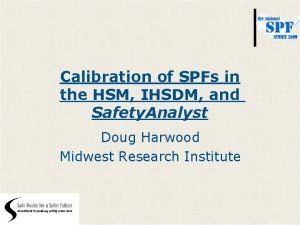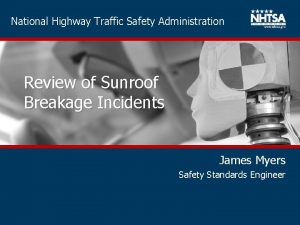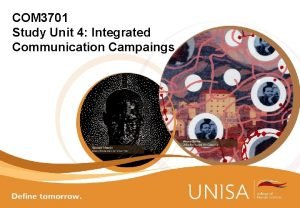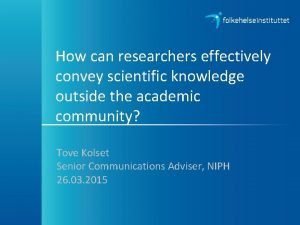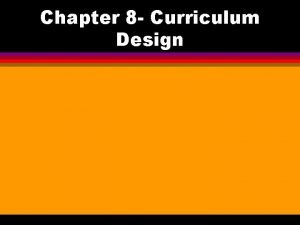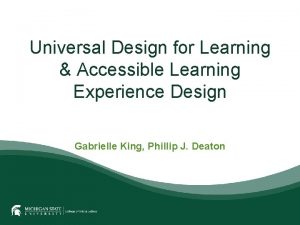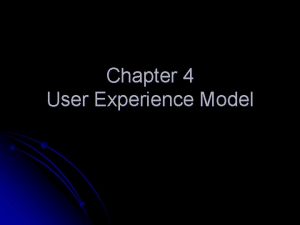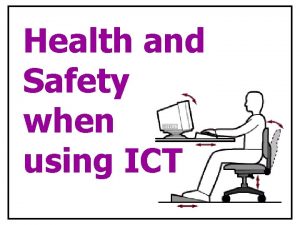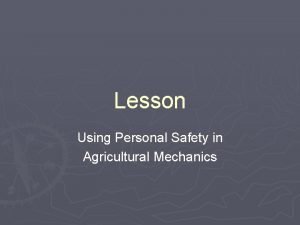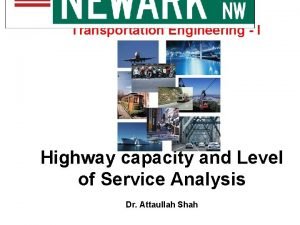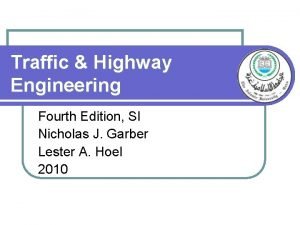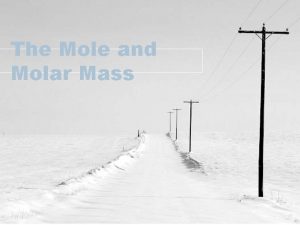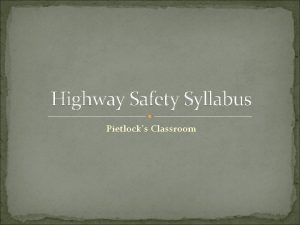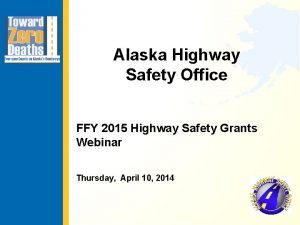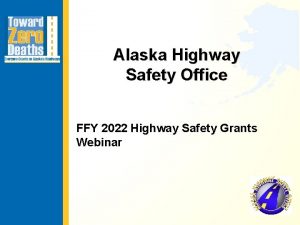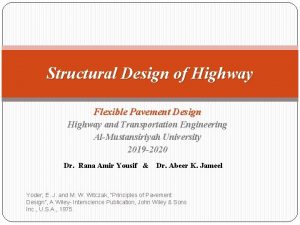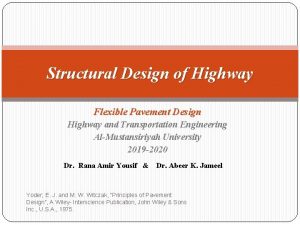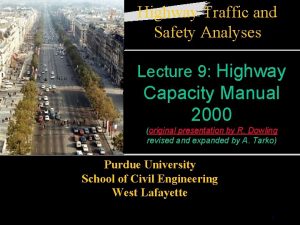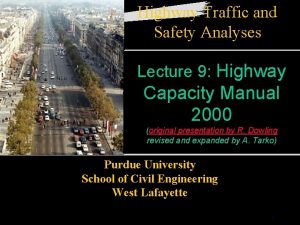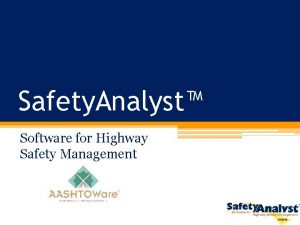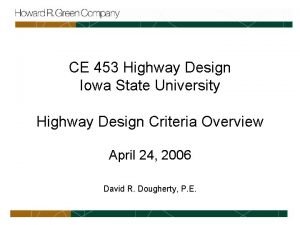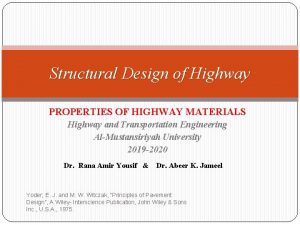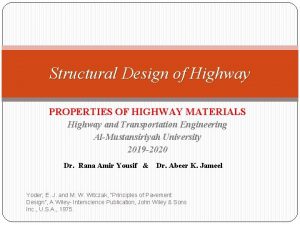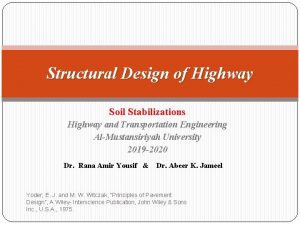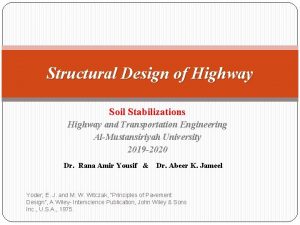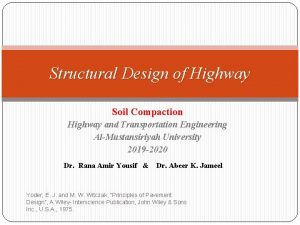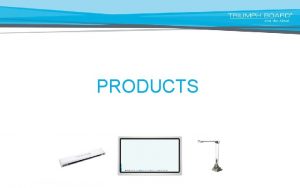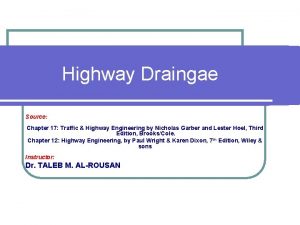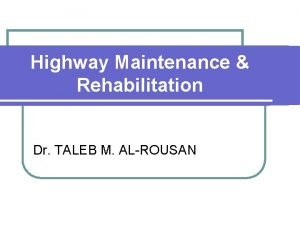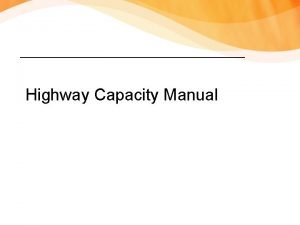Experience Using Interactive Highway Safety Design Model IHSDM



































- Slides: 35

Experience Using Interactive Highway Safety Design Model (IHSDM) To Evaluate 3 R Project Alternatives February 6, 2007 ADOT&PF Design Quarterly Meeting Randy Kinney, P. E. , PTOE, John Pekar, P. E. , Kinney Engineering February 6, 2007 DQM IHSDM Application to 3 R Projects

Presentation Overview o o o 3 R (Resurfacing, Restoration & Rehabilitation) Analysis Overview IHSDM Overview De. Armoun Road Project Example n o Eagle River Road Project Example n o IHSDM Application and Results Lessons Learned February 6, 2007 DQM IHSDM Application to 3 R Projects 2

Alaska 3 R Projects o o o Repave and extend the pavement structure’s life. Allows cost-effective safety & capacity improvements. 3 R safety procedures are in Alaska Preconstruction Manual Sec. 1160 uses the TRB Special Report 214 formulas February 6, 2007 DQM IHSDM Application to 3 R Projects 3

State of Alaska 3 R Process Improvement to new construction standards isn’t required. February 6, 2007 DQM IHSDM Application to 3 R Projects 4

3 R Procedure Doesn’t Addresso o o Grades- Other research indicates grades contribute to crashes. Sag Curves- Might be significant if night crashes are over represented. TRB 214 Analysis is meant for discrete elements and not overlapping geometric elements. In areas of overlaps, Combined Crash Reduction Factor may be computed as: CRt = 1 – (1 -CR 1) ∙ (1 -CR 2) ∙ …∙ (1 -CRm) February 6, 2007 DQM IHSDM Application to 3 R Projects 5

Interactive Highway Safety Design Model (IHSDM) o o IHSDM is software program that has been developed by FHWA as an evaluation tool for two-lane, rural highways. It consists of 5 modules: n n n Policy Review (PRM)- Evaluates compliance with AASHTO standards (nominal safety review). Crash Prediction (CPM)- Evaluates substantive safety performance. Design Consistency Module (DCM)- Evaluates speed along alternative alignments, identifies large differences between operating and design speeds, and tangent to curve 85 th percentile speeds. February 6, 2007 DQM IHSDM Application to 3 R Projects 6

n n o Intersections (IRM)- Evaluates operational and safety for intersections Traffic Analysis (TAM)- Evaluates traffic flow and operations using TWOPASS (basis of the HCM 2000 methodology). Download program and manuals from: http: //www. fhwa. dot. gov/ihsdm/index. htm February 6, 2007 DQM IHSDM Application to 3 R Projects 7

Crash Prediction Module of IHSDM o o o An interactive tool that evaluates the highway as a system, rather than discrete geometric elements. Provides future safety performance measures…rates, frequency, etc. 2 -Lane accident modification factors (AMF) based on Minnesota and Washington data February 6, 2007 DQM IHSDM Application to 3 R Projects 8

Crash Prediction Module of IHSDM o Inputs used for analysisn n n n n Lane Width Shoulder Type Horizontal Curves: length, radius, presence or absence of spiral transitions, and superelevation Grades No Vertical Curvature AMF Driveway Density Two-Way-Left-Turn-Lanes Passing or Climbing Lanes Roadside Design February 6, 2007 DQM IHSDM Application to 3 R Projects 9

Empirical Bayes Evaluation o IHSDM will perform an Empirical Bayes (EB) Procedure crash prediction. n n EB accounts for “regression to the mean” Removes some degree of randomness that has little to do with conditions. Applies historic crash profile to future traffic profile (volumes) Will not apply historic crash profile to new alignment alternatives February 6, 2007 DQM IHSDM Application to 3 R Projects 10

De. Armoun Road Project o o o Collector, rolling & mountainous terrain 11 -foot lanes, 1 -foot shoulders ≈50 mph 85 th percentile speed (40 mph posted) 1, 000 foot segment with deficient geometrics and a significant crash experience, Currin Circle Curve. Past 10 -year average AADT in study area=1, 600 About 2, 000 AADT now, and 2026 AADT is forecasted to be 3, 100 February 6, 2007 DQM IHSDM Application to 3 R Projects 11

Currin Circle Curve February 6, 2007 DQM IHSDM Application to 3 R Projects 12

Currin Circle Crash Experience o o 16 reported crashes over 10 years. The majority of reported crashes were not on snow and ice. Majority are single vehicle types, involving drivers that don’t live on the roadway. There is a higher percentage of night crashes here than the statewide averages. The above points to an driver expectancy problem. This 1, 000 -foot segment is highly inconsistent with remainder of road where 50 mph is the 85 th percentile speed. February 6, 2007 DQM IHSDM Application to 3 R Projects 13

Currin Circle Crash Experience (cont’d) o Segment crash rate is about 13 crashes/million-vehicle-miles. Statistically significant when compared to statewide collector rate of 3. 5 crashes/MVM February 6, 2007 DQM IHSDM Application to 3 R Projects 14

240 -FOOT H. C. ; V= 25 MPH Dominate Direction for Single Vehicle Crashes PAVEMENT WIDTH= 24 FEET February 6, 2007 DQM IHSDM Application to 3 R Projects 15

Dominate Direction for Single Vehicle Crashes Currin Circle Curve 16 Crashes (1 not shown) February 6, 2007 DQM IHSDM Application to 3 R Projects 16

Vertical Curve and Grade Hides Horizontal Curve February 6, 2007 DQM IHSDM Application to 3 R Projects 17

Currin Circle Curve at Night (High-Beam) February 6, 2007 DQM IHSDM Application to 3 R Projects 18

3 R Results- 3 Alternatives o o o 240 R: Existing radius, widen pavement to 36 feet vertical improvements 443 R: 443 -foot radius (V=35 mph), widen pavement to 36 feet , vertical improvements 835 R: 835 -foot radius (V=50 mph), widen pavement to 36 feet , vertical improvements Because of the high and uncertain CRF, and significant impacts on private parties, it was decided to use IHSDM to evaluate the area. February 6, 2007 DQM IHSDM Application to 3 R Projects 19

IHSDM Evaluations o o Added Alternatives Used IHSDM to evaluate 20 years of crashes for: n Existing Conditions n Base: Existing Alignment, 36 -foot pavement widening n 240 R: 240’ radius Currin Cir. Curve, vertical realignment with 36 feet of pavement widening n 265 R: 265’ radius curve, vertical realignment, with and without widening n 300 R: 300’ radius curve, vertical realignment, with and without widening n 443 R: 443’ radius (35 mph) curve, vertical realignment, with and without widening n 835 R: 835’ radius (50 mph) curve, vertical realignment, with and without widening All alternatives shared a common start and ending point outside of critical geometric elements to avoid bias of altering length of geometric element. February 6, 2007 DQM IHSDM Application to 3 R Projects 20

Empirical Bayes (EB) Evaluation of Future Crashes on Existing Alignment n n n Input past crash history, ADT, over study period IHSDM EB procedure forecasts 44 crashes within existing Currin Circle Curve area over the next 20 years, with AADT increasing from 2, 000 now to 3, 100 in 20 years However, remember that EB won’t work on new alignments, therefore you must use a “relative” evaluation. February 6, 2007 DQM IHSDM Application to 3 R Projects 21

February 6, 2007 DQM IHSDM Application to 3 R Projects 22

IHSDM Model Example Results (No EB adjustment) CRF =Crash reduction factor, percent N Alternative =Number of accidents predicted by IHSDM Model for the alternative during design life 2006 to 2026 N Existing =Number of accidents predicted by IHSDM Model for the existing roadway during the design life 2006 to 2026 February 6, 2007 DQM IHSDM Application to 3 R Projects 23

Relative Crash Reduction (3 R Results) February 6, 2007 DQM IHSDM Application to 3 R Projects 24

Eagle River Road Rehabilitation Project February 6, 2007 DQM IHSDM Application to 3 R Projects 25

Eagle River Road Rehabilitation Project - Background o Collector, rolling & mountainous terrain o 12 -foot lanes, 4 -foot shoulders (Segment 1) o 11 -foot lanes, 1 -foot shoulders (Segments 2 & 3) o o ≈60 mph 85 th percentile speed (45 mph posted) Past 10 -year average AADT in study area, 4, 045 (seg. 1) , 1, 270 (seg. 2) , 552 (seg. 3) Crash History Past 10 -years, 44 (seg. 1) , 108 (seg. 2) , 18 (seg. 3) Forecasted 20 -year average AADT, 6, 804 (seg. 1) , 2, 652 (seg. 2) , 988 (seg. 3) February 6, 2007 DQM IHSDM Application to 3 R Projects 26

Eagle River Road Rehabilitation Project Segment 2 Photo: Looking South East to the End of Project February 6, 2007 DQM IHSDM Application to 3 R Projects 27

Eagle River Road Rehabilitation Project – 3 R Recommendations o o 12’ Lanes & 4’ shoulders for Segments 2 & 3 17 of 37 Horizontal Curves do not meet AASHTO n Improve 11 Horizontal Curves based on accident rate 20 of 29 Crest Vertical Curves do not meet AASHTO n Improve 5 Crest Vertical Curves based on accident rate Intersection Crash Rates were not high, although 12 of 19 did not provide intersection sight distances. February 6, 2007 DQM IHSDM Application to 3 R Projects 28

Eagle River Road Rehabilitation Project – 3 R Analysis Review o Proposed 3 R improvements will leave some existing Horizontal and Vertical curves in place n n n Do the resulting improvements produce a consistent design ? Are there overlapping geometric elements that should be considered ? Can IHSDM be used to improve the design ? February 6, 2007 DQM IHSDM Application to 3 R Projects 29

Eagle River Road Rehabilitation Project – IHSDM Sensitivity Analysis February 6, 2007 DQM IHSDM Application to 3 R Projects 30

Eagle River Road Rehabilitation Project - Design Consistency Module o Evaluates the geometry’s conformance with diver expectations o One expectation: operate uniformly at/near design speed. o The measure of consistency for this check is the difference between the estimated 85 th percentile speed (V 85) and the design speed (Vdesign) of the highway. February 6, 2007 DQM IHSDM Application to 3 R Projects 31

Eagle River Road Rehabilitation Project – Design Consistency RT Lane February 6, 2007 DQM IHSDM Application to 3 R Projects 32

Eagle River Road Rehabilitation Project – Design Consistency LT Lane February 6, 2007 DQM IHSDM Application to 3 R Projects 33

Lessons Learned o o o IHSDM is a good tool for evaluating 2 -lane alternatives. Applicable to new projects as well as 3 R analysis (may be superior to current 3 R methods when geometrics are overlapping) These models were un-calibrated; therefore only a relative performance measure can be used (CRF). There is significant benefit in calibrating models (calibration has become easier with recent IHSDM release). February 6, 2007 DQM IHSDM Application to 3 R Projects 34

Lessons Learned o o o Analysis of individual geometric elements with IHSDM requires engineering judgment. In fact, it is best used for evaluating geometric systems. (May be biased when only evaluating discrete, individual elements!) Selection of Road Side Hazard Rating is the most sensitive element in accident forecast. IHSDM’s Consistency Analysis is a good tool for refining proposed designs. February 6, 2007 DQM IHSDM Application to 3 R Projects 35
 Ihsdm
Ihsdm Ihsdm
Ihsdm National highway safety administration reviews
National highway safety administration reviews Understanding experience in interactive systems
Understanding experience in interactive systems Imprinting psychology
Imprinting psychology Early experience vs. later experience
Early experience vs. later experience Indirect experience
Indirect experience Models of communication linear
Models of communication linear Linear communication model
Linear communication model Objectives of geometric design in roads
Objectives of geometric design in roads What is interactive system design
What is interactive system design Interactive science notebook cover design
Interactive science notebook cover design Weaknesses of taba model
Weaknesses of taba model Interactive reading model
Interactive reading model Interactive model of communication campaigns four phases
Interactive model of communication campaigns four phases Top down strategy in reading
Top down strategy in reading Bottom up reading model
Bottom up reading model Interactional model of communication
Interactional model of communication Life situation design curriculum
Life situation design curriculum Accessible learning experience design and implementation
Accessible learning experience design and implementation Where do you activate the four shades function for the encs
Where do you activate the four shades function for the encs Safety care certification
Safety care certification Process safety vs personal safety
Process safety vs personal safety Ind safety report
Ind safety report Basic safety (construction site safety orientation)
Basic safety (construction site safety orientation) 00101-15 basic safety
00101-15 basic safety Maturity model template
Maturity model template User experience model
User experience model What is the supportive stance
What is the supportive stance What are the four crisis development/behavior levels
What are the four crisis development/behavior levels Health and safety precautions when using ict
Health and safety precautions when using ict Shop safety color coding system
Shop safety color coding system What is the purpose of finger waving?
What is the purpose of finger waving? Highway capacity and level of service
Highway capacity and level of service Traffic and highway engineering 4th edition
Traffic and highway engineering 4th edition Mole highway
Mole highway
